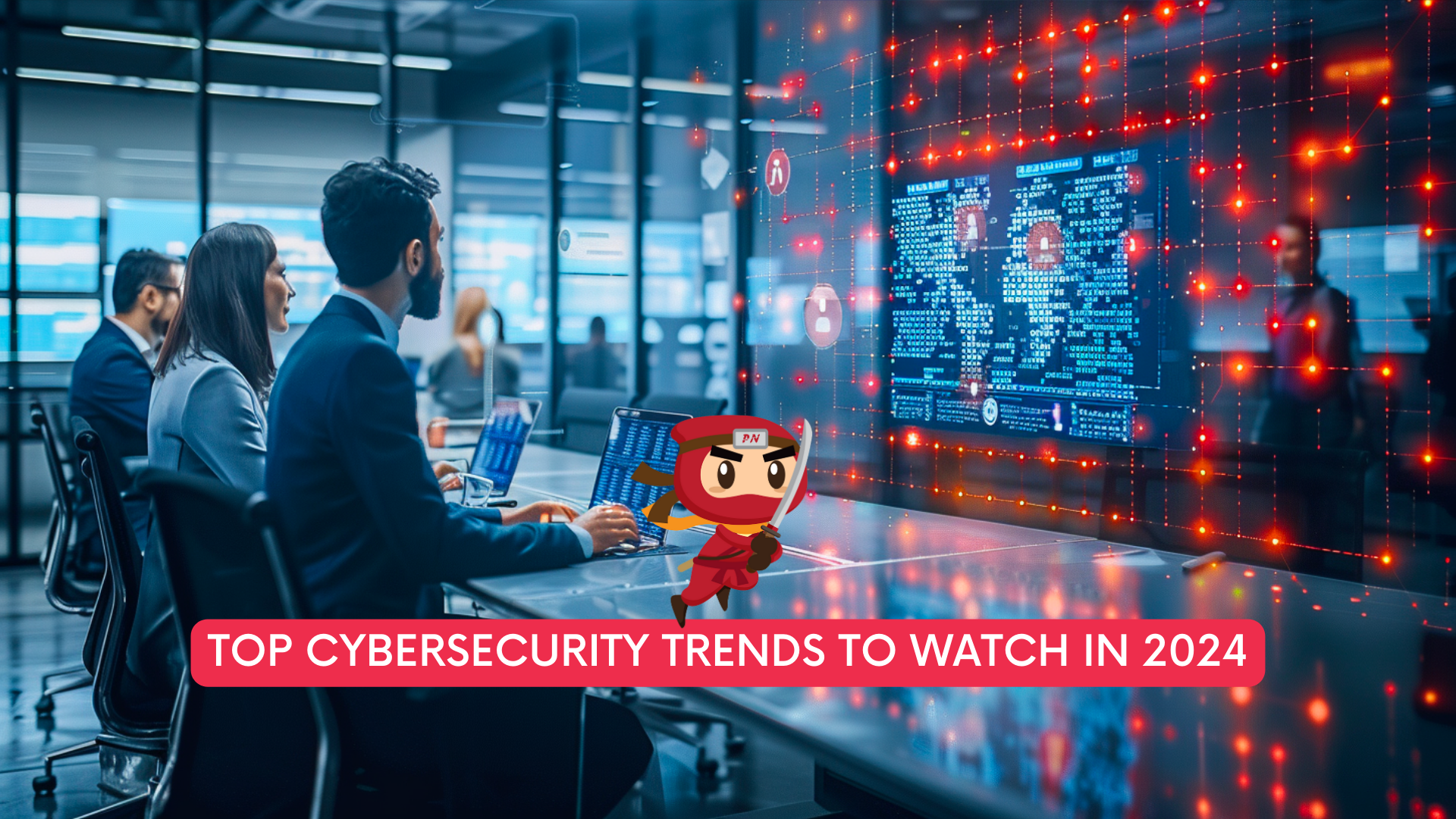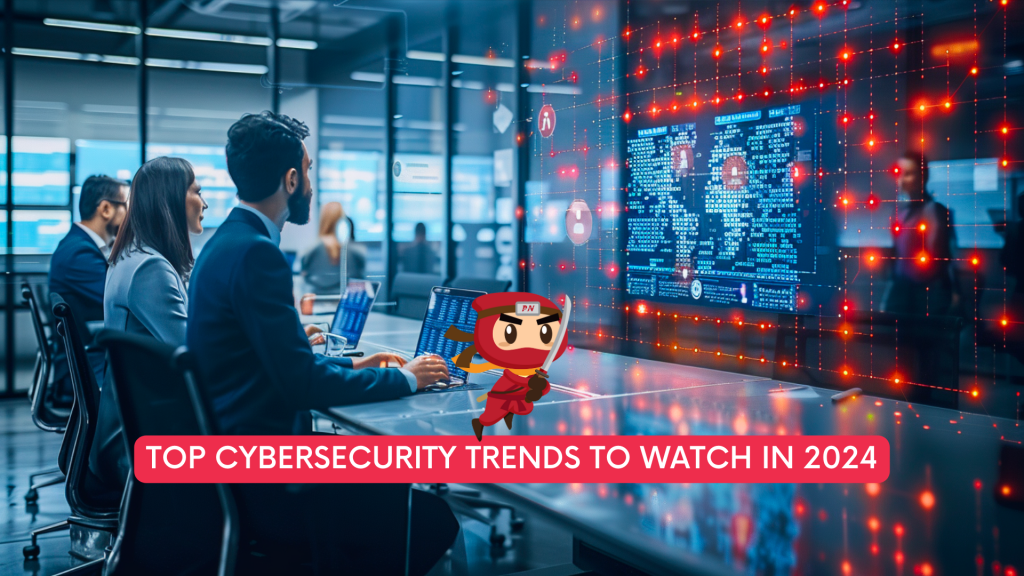KEEP IN TOUCH
Subscribe to our mailing list to get free tips on Data Protection and Cybersecurity updates weekly!



Cybersecurity continues to be a top priority for individuals, businesses, and governments alike. As technology evolves, so do the tactics and techniques employed by cybercriminals. Staying ahead of emerging threats and trends is crucial for effectively protecting sensitive data and mitigating cyber risks. In this article, we’ll explore the top cybersecurity trends to watch in 2024 and how they are shaping the future of cybersecurity.
Artificial intelligence (AI) and machine learning (ML) are revolutionizing cybersecurity by enabling more proactive and adaptive defense mechanisms. In 2024, we can expect to see increased integration of AI and ML technologies into security solutions. These technologies are adept at analyzing vast amounts of data to identify patterns and anomalies that may indicate potential threats. From threat detection to automated incident response, AI and ML are transforming cybersecurity operations, making them more efficient and effective.
Zero Trust Architecture (ZTA) is gaining traction as organizations recognize the limitations of traditional perimeter-based security models. In 2024, we anticipate a broader adoption of ZTA principles, which assume that threats may already exist within the network and require continuous verification of users and devices. With ZTA, access controls are strictly enforced based on the principle of least privilege, ensuring that users only have access to the resources they need to perform their roles. This approach helps minimize the impact of potential breaches and strengthens overall security posture.

With the advancement of quantum computing, traditional cryptographic algorithms are at risk of being compromised. Quantum-safe cryptography, also known as post-quantum cryptography, is an emerging field focused on developing algorithms that are resistant to quantum attacks. In 2024, organizations are expected to start transitioning to quantum-safe encryption protocols to future-proof their data against emerging threats posed by quantum computing. This proactive approach to cryptography is essential for maintaining data confidentiality and integrity in the face of evolving technology.
Secure Access Service Edge (SASE) is a comprehensive security framework that integrates networking and security functions into a cloud-native architecture. In 2024, the adoption of SASE is poised to accelerate as organizations seek to secure their increasingly distributed and remote workforces. By consolidating security capabilities such as secure web gateways, firewall as a service, and zero trust network access, SASE offers a unified approach to network security that is scalable, flexible, and adaptable to changing business needs.
Extended Detection and Response (XDR) is an evolution of traditional endpoint detection and response (EDR) solutions, offering broader visibility and context across multiple security layers. In 2024, XDR platforms will play a critical role in threat detection and response, integrating data from endpoints, networks, cloud environments, and applications to provide a holistic view of the security landscape. By correlating and analyzing diverse data sources, XDR enables faster detection of sophisticated threats and more effective incident response actions.
As organizations continue to migrate their workloads to the cloud, ensuring the security of cloud environments becomes paramount. Cloud Security Posture Management (CSPM) solutions help organizations proactively identify and remediate misconfigurations and security risks in their cloud infrastructure. In 2024, CSPM adoption will increase as organizations seek to enhance their cloud security posture and comply with regulatory requirements governing cloud usage.
Identity-centric security focuses on protecting digital identities and ensuring that only authorized users have access to resources and data. In 2024, we anticipate a greater emphasis on identity-centric security solutions, including multi-factor authentication (MFA), identity and access management (IAM), and privileged access management (PAM). By prioritizing identity as the new security perimeter, organizations can better defend against insider threats, credential-based attacks, and unauthorized access attempts.
The cybersecurity skills shortage continues to be a significant challenge for organizations worldwide. In 2024, the demand for skilled cybersecurity professionals is expected to outstrip supply, exacerbating the talent gap. To address this challenge, organizations will need to invest in training and upskilling their existing workforce, as well as exploring alternative talent sources such as automation and managed security services.

As we navigate the complex and evolving landscape of cybersecurity in 2024, staying informed about emerging trends and technologies is essential for organizations seeking to protect their assets and mitigate cyber risks. From artificial intelligence and machine learning to quantum-safe cryptography and zero trust architecture, the cybersecurity trends shaping the future are diverse and dynamic. By embracing these trends and adopting a proactive approach to cybersecurity, organizations can enhance their resilience and readiness to face the challenges of an increasingly digital world.
Your appointed DPO can work with you on your PDPA compliance, ensuring that there will be policies in place to make sure that the handling of personal data is PDPA compliant.
A Data Protection Officer (DPO) oversees data protection responsibilities and ensures that organisations comply with the Personal Data Protection Act (PDPA). Furthermore, every Organisation’s DPO should be able to curb any instances of PDPA noncompliance as it is the officer responsible for maintaining the positive posture of an organisation’s cybersecurity.
DPOs complement organisations’ efforts to ensure that the organisation’s methods of collecting personal data comply with the PDPA. It also ensures that policies are set in place to make sure that there will be no instances of data breaches in the future.
Don’t wait any longer to ensure your organisation is PDPA compliant. Take our free 3-minute PDPA Compliance Self-audit checklist now, the same “secret weapon” used by our clients to keep them on track. Upon completion, we will send you the results so you can take the necessary action to protect your customers’ data. Complete the free assessment checklist today and take the first step towards protecting your customers’ personal data.